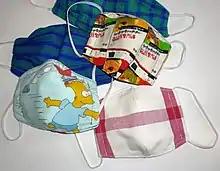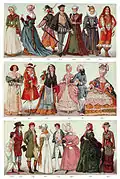2020s in fashion
Fashions of the 2020s represent a backlash against 2010s fashion and have thus far been largely inspired by fashions of the 1980s and 2000s.[1][2][3]
General trends
COVID-19 pandemic

The global COVID-19 pandemic which dominated events in the early part of decade also influenced fashion. Wearing a facemask became a common and often mandatory practice to prevent the spread of the virus.[4] While initially utilitarian the human desire for self-expression and the ability of brands to quickly design and make effective coronamasks with only nonspecialized cloth technology soon led to a great diversity of mask designs.[5][6]
Women's clothing
Relaxedwear
The spring of 2020 was characterised by a rejection of the form-fitting 2010s fashion in the UK and Europe, due in part to the coronavirus lockdown and a resurgence of interest in late 1990s to early 2000s fashion. Fairtrade, vintage and vegan friendly clothing free from wool and leather went mainstream in reaction to the needless disposal of unsold fast fashion clothes, and also in response to the closure of high street stores during the coronavirus pandemic.[7][8][9] By fall 2020, younger women abandoned skinny jeans in favor of sweatpants, leggings, baggy shorts,[10] pants with drawstring waists, loose-fitting shift dresses[11] or blouses, oversized jackets and cardigans,[12][13] and it became acceptable to wear pajamas in public. Popular colors included grey, silver, pale pink, violet, mint green, and faded yellow, pastel blue and red.[14][15] Workplace dress codes became more casual due to a higher proportion of white collar staff working from home.
Men's clothing
1980s revival
From 2020-21, the fashions of the 1980s and the mid-2000s made a comeback as Generation Z reached adulthood and mixed carefully selected contemporary fast fashion with original vintage clothing and recent charity shop finds.[16][17] Popular trends in the UK and America included old school hip-hop inspired satin track jackets, suede desert boots, looser fitting stonewashed jeans, messenger bags featuring throwback logos,[18] Oxford shirts with vertical stripes,[19] sleeveless undershirts, Nike Shox, elements of workwear like fleece jackets or unbranded baseball caps, corduroy, mid-wash double denim, oversized Bermuda shorts in reaction to the effeminate short shorts of the 2010s, off-white or navy color block co-ord hoodies and sweatpants with a stripe down the leg, paint spattered T shirts, retro bowling shirts, striped Rugby shirts, heavily distressed Perfecto motorcycle jackets, black or white monotone plimsolls,[20] chunky hiking sandals, worker boots, combat boots bought as army surplus, black Tees featuring vintage inspired graphics such as muscle cars, comic book characters, advertising brands, classic movie posters such as Star Wars, or sports team logos, and slim-fitting grey or khaki cargo pants worn with matching lightweight M65 field jackets with lots of external patch pockets.[21] Desirable colors included white, yellow, lime green, brown, orange, burgundy, and pale blue.[22] In the UK, Italy, Belgium,[23] and throughout the Middle East, keffiyehs became particularly popular to block viruses (though they are less effective than surgical masks) and/or to show support for socialism or Palestinian nationalism.[24][25]
Hairstyles
Women
Due to the restrictions on hairdressers opening during the COVID-19 lockdown,[26] many British women grew out their hair. Side ponytails and buns were popular, and many teen girls and young women wore oversized 80s style bows in imitation of pop star Sia and dancer Jojo Siwa. A few attempted DIY haircuts while self-isolating, with varying degrees of success.
Men
Beginning in 2020, the wearing of a full beard associated with the hipster subculture underwent a decline, except in Brazil, Morocco, Egypt, Uruguay, Paraguay, Algeria, Argentina and others where wearing of a full beard continuous the dominant fashion for almost 100% men in this countries. When worn, beards were trimmed short to facilitate the wearing of a face mask.[27] Side parted or centrally parted curtained hair inspired by 1990s and early 2000s fashion saw a comeback among teenagers and young adult men due to barbershops being forced to close during the lockdowns in the UK and America. Meanwhile, many balding men over 30 continued to get buzzcuts at home.
See also
References
- Rhys McKay, ed. (25 February 2020). "The 10 Best Trends From 2000s Fashion For Men". Who. Retrieved 25 September 2020.
- Diandra Malivindi, ed. (27 May 2020). "9 Trends From The 2000s That Are Surprisingly Back In Style". InStyle. Archived from the original on 26 September 2020. Retrieved 25 September 2020.
- "Gen Z Is Bringing the 2000s Back…Here's How Brands Can Keep Up". YPulse. 18 February 2020. Archived from the original on 26 September 2020. Retrieved 25 September 2020.
- "StackPath". dailynewsegypt.com. Retrieved 2021-01-26.
- Philipkoski, Kristen (12 April 2020). "30+ Fashion Brands Pivoting To Make Stylish Coronavirus Masks". Forbes. Retrieved 8 May 2020.
- Friedman, Vanessa (22 April 2020). "Should Masks Be a Fashion Statement?". The New York Times. Retrieved 8 May 2020.
- [Discovery_Cards-[Multi_Site]-[SL02]-[PS_SOUNDS~N~~FahionFixFeb2nd] Charlie Howard fashion fixes]
- Sustainable vegan trainers
- Topshop closure
- Marie Claire
- Vogue
- Spring 2020 trends
- Glamor Mag
- Spring 2020 trends
- Elle 2021
- 2000s revival on Fashionbeans
- Fashion trends to leave behind in 2021
- Trend spotter
- Ape to gentleman
- Ape to Gentleman
- GQ Spring 2020 trends
- GQ Spring 2020
- The Art Newspaper
- Keffiyeh worn as alternative to facemask
- Keffiyeh mask
- Welsh salon breaches lockdown
- Decline of beards
